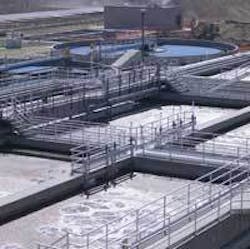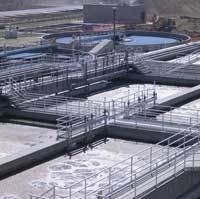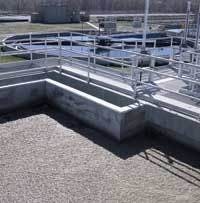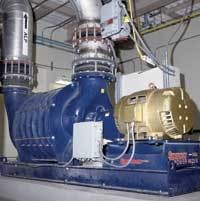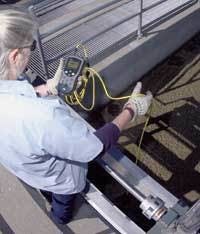New Portable Metering System Increases Confidence in Field Measurements
Operators at the Loveland, CO, wastewater treatment plant have found that precise measurement of dissolved oxygen (DO) concentration is critical in the plant’s step-feed aeration process. Operators use hand-held instruments to gather “snapshots” of conditions in the facility’s various processes and to verify the performance of their on-line DO control system.
While advanced on-line instrumentation provides continuous measurements for real-time process control, the use of portable hand-held instruments plays a critical role in day-to-day field operations at municipal wastewater treatment plants.
Operators are increasingly demanding that portable units provide accurate, repeatable measurement, are easy to use and sufficiently durable to hold up to the rigors of field testing. Most importantly, the user must feel confident in the measurements that portable units provide.
At the 10 mgd Loveland facility, field measurements are particularly important in the plant’s modified activated sludge process -- for both validating and fine-tuning automated control systems to ensure proper wastewater treatment in the plant’s step-feed aeration process.
Step-feed aeration, initiated by the plant in October 2004 to meet more stringent ammonia limits, consists of parallel sets of three in-line aeration basins through which raw water progresses before flowing by gravity to the plant’s final clarifiers. Rather than all of the primary effluent entering at the head of the first aeration tank and flowing through the tanks in a plug flow mode, as in a conventional activated sludge process, each basin instead receives a portion of raw water. Additionally, return sludge is introduced only at the head of the first aeration tanks of both trains.
With this process, oxygen demand is more uniformly distributed, thereby enhancing ammonia removal. Dissolved oxygen is the critical measurement for process control. Sufficient oxygen must be maintained in each of the six basins at all times to ensure complete waste stabilization. Insufficient oxygen will slow down or kill off the aerobic organisms the basins are designed to cultivate. If DO levels are too high, however, it can result in excessive power consumption and create conditions ripe for developing undesirable organisms.
Oxygen for the plant’s aeration system is provided by two 250 hp and two 200 hp positive displacement blowers supplying a combined average of around 6,500 scfm. Six on-line Hach LDO® (Luminescence Dissolved Oxygen) probes, each positioned downstream from the outlet of each basin, are read continuously by three Hach sc100 controllers that communicate to the plant’s SCADA system for process control.
Field DO Measurements
“Our blowers are equipped with variable frequency drives and our on-line system automatically tells the blowers when to ramp up, ramp down, and turn off or on individually, depending upon the real-time DO levels within each basin,” said plant operator Cindi Rutledge. “Having tight DO control is essential not only for meeting our permit but for saving money, because the electrical power required to run these blowers can be very expensive. That’s why we take field DO measurements on a scheduled basis using handheld units -- to continually make sure our air calibrations are correct, that our on-line meters are performing well and that we are running our air system as optimally as possible.”
Operators at the Loveland plant recently participated in beta testing the Hach HQ40d portable electrochemical meter, the first instrument for field and laboratory use that does not require the user to predetermine parameters. Using the company’s new IntelliCALTM probes, a single HQd-series meter can take up to two simultaneous measurements of pH, conductivity, and LDO®.
“We tested the new meter primarily for DO measurement out in the plant, outfitting it with an IntelliCAL LDO probe,” Rutledge said. “We were very interested in participating as a beta test site because oxygen levels are so important to our plant’s performance and taking spot readings is such a significant task. Anything that can potentially make our job more accurate and more efficient is something we’re definitely interested in looking into.”
Battling Uncertainty
Another important reason for participating in the beta test was the Loveland plant operators’ need to attain a higher level of certainty in spot DO measurements. Up until mid 2005, they had been using a portable membrane-type DO meter that used the polarographic method of DO analysis.
“It’s very important that our basin probes always are within range of our hand-held unit,” Rutledge said. “But with our membrane-type DO unit we were never truly certain; there was enough difference in the readings for us to never be really sure of our control. We wanted no more than 0.5 mg/L difference, but we would repeatedly get readings on our hand-held unit that were anywhere from 1.0 mg/L to 2.5 mg/L different than our on-line LDO probes.”
In a move to help gain better certainty in spot DO measurement, the plant switched to using a Hach portable LDO meter in June 2005.
“The hand-held LDO meter was quite an improvement,” Rutledge said. “It tracked very well with our basin probes. When the meter locked in a number you felt a lot more confident in the reading. Also, it was self-calibrating and the system had a lot of useful features.”
Beta Test
The HQd-series of meters has an intuitive user interface with guided self-calibration for all parameters (pH, conductivity, and LDO), reducing the chance for calibration errors. Hach LDO technology does not require on-going calibration, however some users have incorporated it into their routine. The new IntelliCAL plug-and-play probes save time because the last known calibration and calibration history are stored in the probe, reducing the need to recalibrate when moving from one meter to another - very valuable for pH and conductivity measurement. The system provides reporting data, including time and date, sample ID, and user ID, so that users can store and monitor previous readings.
“We liked our Hach LDO meter - it was a significant improvement over the membrane-type unit we had been using,” Rutledge said. “But when I took the HQ40d meter out in the plant and tested it against the LDO meter, I could run five tests with it in the same time it took me to perform only one with the other unit. It locks in very quickly. Also, a calibration system alerts the user to when recalibration is needed. This, combined with the faster response time, gave us increased confidence in our results.”
During the two month beta test, operators ran the new meter at least three times a day, performing dissolved oxygen measurements on all six aeration basins for comparison to the on-line LDO meters. They also used it for calibration purposes against the other hand-held meter, as well as to measure DO in the plant’s secondary clarifier and final discharge.
“With this new unit, we just put the probe in a saturated area and it basically goes through its calibration and then tells us how it calibrated compared to the previous calibration,” Rutledge said. “It gave us a much more secure feeling as far as the accuracy of our measurements.”
Based on the positive experience gained from the beta test, the Loveland plant decided to switch to the new handheld meter.
“Calibration is easy, repeatability is very good, and we like the fact that it stores readings that can be tracked by operator and even be downloaded to a printer or PC,” Rutledge said.
Fine-Tuning
Ever since the switch to the step-feed aeration process, operators at the Loveland plant had been looking to bring more certainty to spot DO measurements. They view switching to the new hand-held meter as a positive step.
“Step-feed aeration is a new process for us and it’s something to get used to,” Rutledge said. “It’s different. You can make changes and immediately see changes. If we have a DO problem and don’t catch it, we definitely see it in our electricity bills.
“Having the right monitoring tool is very important,” she said. “For example, we’re now able to correlate data between our aeration basin discharge points versus where our permanent LDO meters are located 2-3 minutes downstream - and we’ve found there’s about half a milligram difference. This is the type of information we can work with over time to fine-tune our process. And because the new meter is multi-parameter, we now have simultaneous pH measurement capabilities. We’re planning to site-test pH to determine if any one basin is getting more gas release, and we’ll be able to use this data to help further optimize our system.”
About the Author:
Chad C. Bertram is Program Manager & Product-Line Manager for Hach Co. He may be contacted at Tel: 970-663-1377 x2644 or via e-mail at [email protected].
